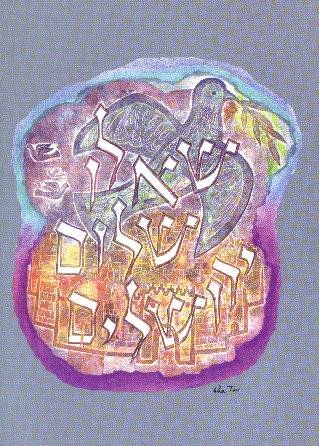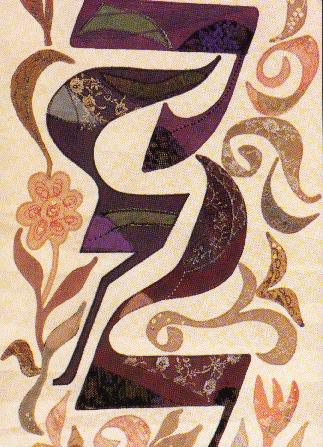Tkhines
|
Tkhines are prayers that were primarily developed for Jewish women, by
Jewish women. They began in the seventeenth century and are now being reclaimed by Jewish women as a way to participate
more fully in their religious tradition. Scholars are now researching the older tkhines to find out about
the life of Jewish women in the seventeenth century. Jewish women today are writing new tkhines that can
be used in a wide variety of situations.
Sample of a Modern Tkhine
Dear G_d, as I begin this paper, grant me the wisdom to uncover the
hidden sparks of the Torah. Send me your angels to guide me on my way as I stumble through sentence construction
and footnotes. Bless me with fertility of ideas as you have blessed my ancestors Sara, Rebecca, Rachel, and Leah.
Give me patience and endurance to finish this paper on time and the ability to enjoy my work in the process. See
this effort as my humble way to draw closer to you and to bring humankind closer to redemption. May the wings of
Shechinah hover over me as I work, keeping me safe from doubts and exhaustion. Grant me serenity in my endeavor
and let me say, amen.
Geela Rayzel Raphel, 1993 (Weissler 149).
|
Interest and Origin
The tkhines are set prayers aimed mostly for a female audience. They first
appeared in Jewish culture in the seventeenth century. They were intended for the intellectual middle class and
are now published in anthologies. The tkhines have not always been deemed valuable by the authorities of
the day. It was considered not worth the effort to attempt to compile the tkhines in some form of anthology
for a while after the beginning of the tkhine tradition. Eventually women compiled prayer books that consisted
of the most popular tkhines. These common prayers strengthen Jewish women's sense of community and offered
them another opportunity for religious expression. Interest in the tkhines picked up as the Reform movement
began to surface. This was the result of the Reformist's desire for Jews to pray in the language that they spoke,
instead of in Hebrew. However, the leaders of this movement did not bother to acknowledge that these prayers had
been primarily written for women. |
 |
Development of the Tkhine
At the end of World War II there was a shift in the types of prayers written. There
were noticeably more prayers for the synagogue and fewer for the home. A trend juxtaposed with this shift is that
women's religious life was moving more into the public sphere. This transition could very well have been the result
of improvements in education for women. The tkhines are viewed as a way for women to reclaim their spirituality.
In order to accomplish this goal new tkhines have to been written in order to keep the prayers as relevant
to modern culture as possible. The trend that has brought us into this decade is a focus on emotional and psychological
needs rather than material needs. "Preserving the text of the techinas would not have been enough.
Presenting them as the obscure relic of an era long past simply increases our loss. These techinas are a
formula for dialogue, a form of address with God. They are an opportunity for today's woman to find her voice and
reconnect her emuna, her faith, as if reconnecting a severed limb. By attaching ourselves to the voices
of our grandmothers, we can again become whole." (Weissler 159).
Conservative Approach:
There are different approaches to the resurgence of interest in the tkhines.
In the Conservative movement a daily and Sabbath prayer book was published in 1985. This book has the dual purpose
of giving women a voice and encouraging private prayer. The prayers included in this book recognize the importance
of experiencing a private religious life as well as the public practice of religion which is usually stressed.
The personal prayers published in this book resemble the tkhines in their content and literary style. In
fitting with modern trends most of the concerns brought up in this prayer book are about finding meaning, hope,
and love along with understanding in the family.
Orthodox Approach:
Recently, feminist prayers and rituals have become increasingly popular in Orthodox
Judaism. New tkhines have been written to be performed at a strikingly diverse group of occasions. Rituals
and prayers have sprung up around pregnancy, postpartum period, naming a daughter, infertility, hysterectomy, divorce,
becoming a vegetarian, becoming "a woman of vision," Hanukkah, Sukkot, and more.
 |
Traditional Tkhines related to
niddah
In the observance of the women's mitzvot the tkhines are strongly linked to
fertility. In general the tkhines stress the rewards that are promised to those who observe the proper commandments.
They highlight the good that will come to those who follow the law rather than the punishment that would result
if the commandments were not observed. Most tkhines that relate to niddah have themes of purity and impurity.
The pure are most often promised offspring that will be studious and pious. The tkhines that were written
specifically for childbirth sometimes look at the issue of how Eve's sin in the garden is affecting women's suffering
in labor. The tkhines put forth the notion that it is God's form of justice and punishment that women suffer
in labor and in their menstrual cycle. It is often recognized that this may seem like an injustice, but that thought
is quickly followed with the reassurance that God's judgments are right and humans can simply not understand God's
ways.
|
Bibliography
Weissler, Chava. "Mizvot Built into the Body: Tkhines for Niddah,
Pregnancy, and Childbirth", in Howard Eilberg-Schwartz, ed., People of the Body. New York: State University
of New York Press, 1992.
Weissler, Chava. Voices of the Matriarchs: Listening to the Prayers of Early Modern
Jewish Women. Boston: Beacon Press, 1998.
Images from:
Women
of Reform Judaism




